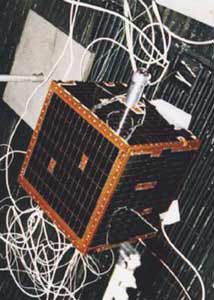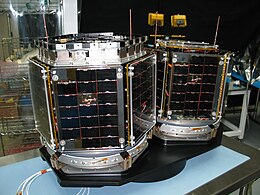
Karol Joseph "Bo" Bobko, , is an American aerospace engineer, retired U.S. Air Force officer, test pilot, and a former USAF and NASA astronaut. Bobko was the first graduate of the US Air Force Academy to travel in space.

A military satellite is an artificial satellite used for a military purpose. The most common missions are intelligence gathering, navigation and military communications.
The Student Space Exploration & Technology Initiative (SSETI) is a unique project put into execution by students from different universities spread over European countries. In collaboration with space industry they aim to build microsatellites together.

The Iranian Space Agency is Iran's governmental space agency. Iran became an orbital-launch-capable nation in 2009. Iran is one of the 24 founding members of the United Nations Committee on the Peaceful Uses of Outer Space (COPUOS), which was set up on 13 December 1958.

The STARSHINE series of three artificial satellites were student participatory missions sponsored by the United States Naval Research Laboratory.
A number of Suborbital spaceflights were conducted during 2008. These consist mostly of sounding rocket missions and missile tests, and include other flights such as an ASAT firing. Between the start of the year and 16 July, at least 43 publicly announced suborbital spaceflights were conducted, the first of them on 11 January.

Three Corner Satellite consisted of three student-built microsatellites flying in formation. Primary mission objectives were to demonstrate formation flying, provide stereoscopic imaging of cloud formations, and demonstrate distributed and autonomous operations.
The University Nanosat Program is a satellite design and fabrication competition for universities. It is jointly administered by the Air Force Office of Scientific Research (AFOSR), the Air Force Research Laboratory (AFRL), the American Institute of Aeronautics and Astronautics (AIAA), the Space Development and Test Wing and the AFRL Space Vehicles Directorate's Spacecraft Technology division. NASA's Goddard Space Flight Center was involved from the program inception through Nanosat-3.
The Thor DSV-2 was a series of sounding rockets, test vehicles, and anti-satellite weapons derived from the Thor Intermediate-range ballistic missile. It was also used as the first stage of several Thor-derived expendable launch systems

SAC-D, also known as Aquarius after its primary instrument, is an Argentine Earth science satellite built by INVAP and operated by CONAE. SAC-D was launched from Vandenberg Air Force Base on 10 June 2011, with a planned mission life of five years. Due to a power system failure, the mission was ended on 8 June 2015.

SwissCube-1 is a Swiss satellite operated by École Polytechnique Fédérale de Lausanne (EPFL). The spacecraft is a single unit CubeSat, which was designed to conduct research into nightglow within the Earth's atmosphere, and to develop technology for future spacecraft. It has also been used for amateur radio. It was the first Swiss satellite to be launched.

Ralphie was a satellite, part of the Three Corner Satellite (3CS) project, a three satellite student research project. It was designed and built by mostly undergraduate students at the University of Colorado Boulder as part of the Air Force Research Laboratory's University Nanosat Program.

Sparkie was a satellite, part of the Three Corner Satellite (3CS) project, a three satellite student research project. It was designed and built by mostly undergraduate students at the Arizona State University as part of the Air Force Research Laboratory's University Nanosat Program.
The Space Programme 2040 is a satellite development and launch programme of the Space and Upper Atmosphere Research Commission (Suparco), Pakistan's supreme space research authority. The Space programme 2040 intends to replace the Badr satellite programme and geo-stationary communication satellite. On 11 August, Paksat-IR was launched from Xichang Satellite Launch Center by China, making it first satellite to be launched under this programme. According to Suparco, five GEO satellites and six low earth orbit (LEO) satellites will be launched between 2011 and 2040.
M-Cubed is a miniaturized satellite built by students at the University of Michigan in a joint project run by the Michigan Exploration Laboratory (MXL) and JPL. It is an example of the popular CubeSat design for amateur satellites. It was launched from Vandenberg Air Force Base on October 28, 2011 atop a Delta II rocket. M-Cubed was launched as a secondary payload to the Suomi NPP satellite, along with AubieSat-1, DICE-1, DICE-2, Explorer-1 Prime, and RAX-2.

Colorado Student Space Weather Experiment (CSSWE) was the sixth National Science Foundation sponsored CubeSat mission. It was built by students at the University of Colorado at Boulder with advising from professionals at the Laboratory for Atmospheric and Space Physics. The CSSWE mission was a joint effort by the University of Colorado's Department of Aerospace Engineering Sciences and Laboratory for Atmospheric and Space Physics. The mission principal investigator was Prof. Xinlin Li, and the Co-PIs are Prof. Scott Palo and Dr. Shri Kanekal. The project manager for the project was Dr. Lauren Blum, the system engineer was Dr. David Gerhardt, and the instrument scientist was Dr. Quintin Schiller.

Lem is the first Polish scientific artificial satellite. It was launched in November 2013 as part of the Bright-star Target Explorer (BRITE) programme. The spacecraft was launched aboard a Dnepr rocket. Named after the Polish science fiction writer Stanisław Lem, it is an optical astronomy spacecraft built by the Space Research Centre of the Polish Academy of Sciences and operated by Centrum Astronomiczne im. Mikołaja Kopernika PAN; one of two Polish contributions to the BRITE constellation along with the Heweliusz satellite.
The University of Georgia Small Satellite Research Laboratory (SSRL), or UGA SSRL, is a research laboratory founded in late 2015 with the goal of launching a student-built spacecraft into low Earth orbit. The SSRL is currently building the University of Georgia's first two satellites. The lab has a Space Act Agreement with the NASA Ames Research Center.

SEDSAT-1 is a U.S. amateur radio satellite built by students and developed at the University of Alabama in Huntsville (UAH).
The German space programme is the set of projects funded by the government of Germany for the exploration and utilisation of outer space. The space programme is run by the German Aerospace Center, who conduct research, plan, and implement the programme on behalf of the German federal government.










